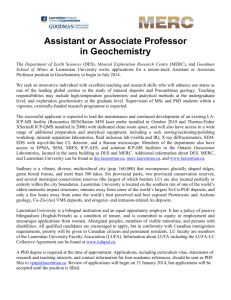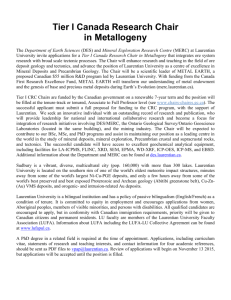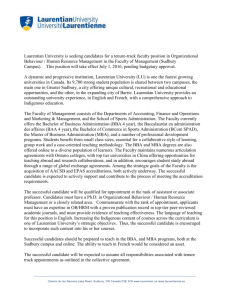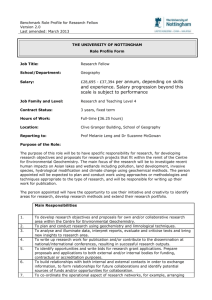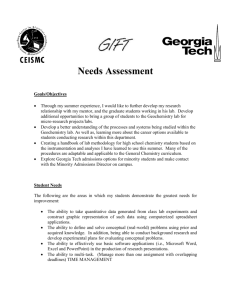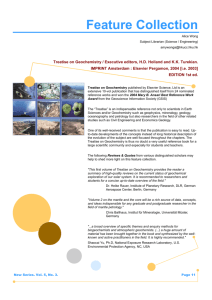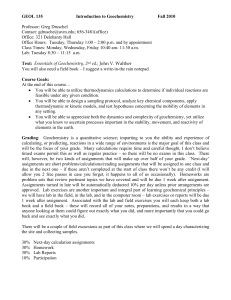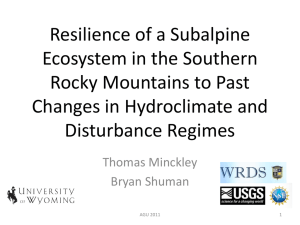Document 11445324
advertisement
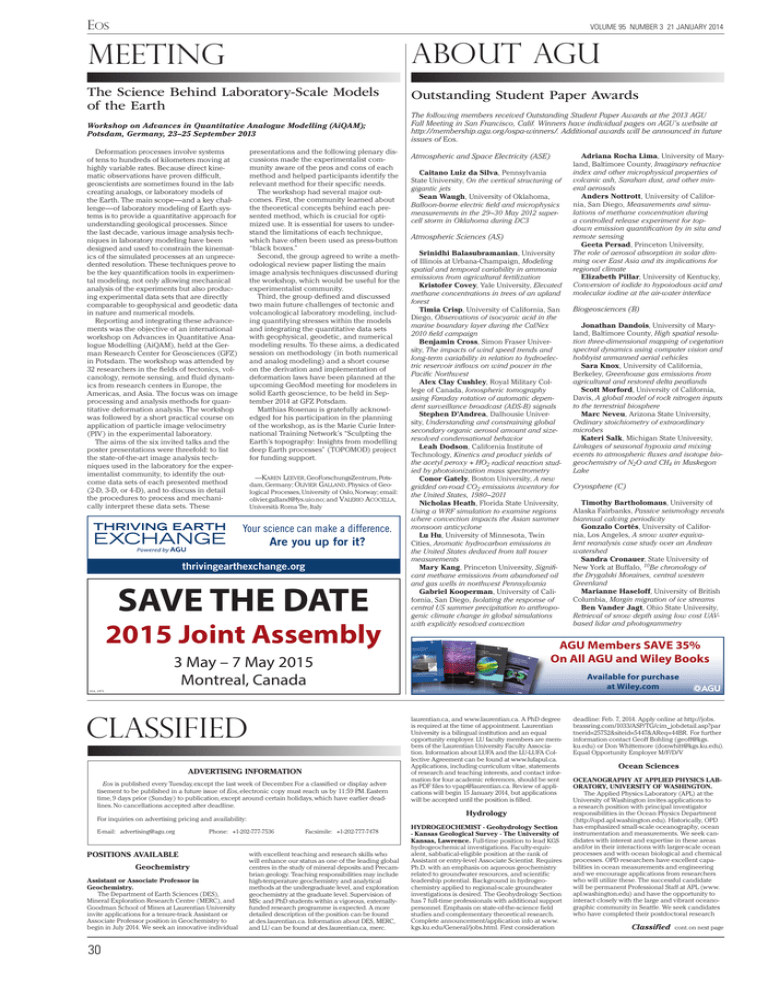
Eos VOLUME 95 NUMBER 3 21 JANUARY 2014 MEETING ABOUT AGU The Science Behind Laboratory-Scale Models of the Earth Outstanding Student Paper Awards Workshop on Advances in Quantitative Analogue Modelling (AiQAM); Potsdam, Germany, 23–25 September 2013 presentations and the following plenary discussions made the experimentalist community aware of the pros and cons of each method and helped participants identify the relevant method for their specific needs. The workshop had several major outcomes. First, the community learned about the theoretical concepts behind each presented method, which is crucial for optimized use. It is essential for users to understand the limitations of each technique, which have often been used as ­press-­button “black boxes.” Second, the group agreed to write a methodological review paper listing the main image analysis techniques discussed during the workshop, which would be useful for the experimentalist community. Third, the group defined and discussed two main future challenges of tectonic and volcanological laboratory modeling, including quantifying stresses within the models and integrating the quantitative data sets with geophysical, geodetic, and numerical modeling results. To these aims, a dedicated session on methodology (in both numerical and analog modeling) and a short course on the derivation and implementation of deformation laws have been planned at the upcoming GeoMod meeting for modelers in solid Earth geoscience, to be held in September 2014 at GFZ Potsdam. Matthias Rosenau is gratefully acknowledged for his participation in the planning of the workshop, as is the Marie Curie International Training Network’s “Sculpting the Earth’s topography: Insights from modelling deep Earth processes” (­TOPOMOD) project for funding support. Deformation processes involve systems of tens to hundreds of kilometers moving at highly variable rates. Because direct kinematic observations have proven difficult, geoscientists are sometimes found in the lab creating analogs, or laboratory models of the Earth. The main scope—and a key challenge—of laboratory modeling of Earth systems is to provide a quantitative approach for understanding geological processes. Since the last decade, various image analysis techniques in laboratory modeling have been designed and used to constrain the kinematics of the simulated processes at an unprecedented resolution. These techniques prove to be the key quantification tools in experimental modeling, not only allowing mechanical analysis of the experiments but also producing experimental data sets that are directly comparable to geophysical and geodetic data in nature and numerical models. Reporting and integrating these advancements was the objective of an international workshop on Advances in Quantitative Analogue Modelling (­AiQAM), held at the German Research Center for Geosciences (GFZ) in Potsdam. The workshop was attended by 32 researchers in the fields of tectonics, volcanology, remote sensing, and fluid dynamics from research centers in Europe, the Americas, and Asia. The focus was on image processing and analysis methods for quantitative deformation analysis. The workshop was followed by a short practical course on application of particle image velocimetry (PIV) in the experimental laboratory. The aims of the six invited talks and the poster presentations were threefold: to list the state-of-the-art image analysis techniques used in the laboratory for the experimentalist community, to identify the outcome data sets of each presented method (­2-D, ­3 -D, or ­4 -D), and to discuss in detail the procedures to process and mechanically interpret these data sets. These —Karen Leever, GeoForschungsZentrum, Potsdam, Germany; Olivier Galland, Physics of Geological Processes, University of Oslo, Norway; e ­ mail: ­olivier.­galland@fys.uio.no; and Valerio Acocella, Università Roma Tre, Italy Your science can make a difference. Are you up for it? thrivingearthexchange.org SAVE THE DATE 2015 Joint Assembly The following members received Outstanding Student Paper Awards at the 2013 AGU Fall Meeting in San Francisco, Calif. Winners have individual pages on AGU’s website at http://membership.agu.org/ospa-winners/. Additional awards will be announced in future issues of Eos. Atmospheric and Space Electricity (ASE) Caitano Luiz da Silva, Pennsylvania State University, On the vertical structuring of gigantic jets Sean Waugh, University of Oklahoma, Balloon-borne electric field and microphysics measurements in the 29–30 May 2012 supercell storm in Oklahoma during DC3 Atmospheric Sciences (AS) Srinidhi Balasubramanian, University of Illinois at ­Urbana- ­Champaign, Modeling spatial and temporal variability in ammonia emissions from agricultural fertilization Kristofer Covey, Yale University, Elevated methane concentrations in trees of an upland forest Timia Crisp, University of California, San Diego, Observations of isocyanic acid in the marine boundary layer during the C ­ alNex 2010 field campaign Benjamin Cross, Simon Fraser University, The impacts of wind speed trends and long-term variability in relation to hydroelectric reservoir inflows on wind power in the Pacific Northwest Alex Clay Cushley, Royal Military College of Canada, Ionospheric tomography using Faraday rotation of automatic dependent surveillance broadcast (­A DS-B) signals Stephen D’Andrea, Dalhousie University, Understanding and constraining global secondary organic aerosol amount and sizeresolved condensational behavior Leah Dodson, California Institute of Technology, Kinetics and product yields of the acetyl peroxy + HO2 radical reaction studied by photoionization mass spectrometry Conor Gately, Boston University, A new gridded on-road CO2 emissions inventory for the United States, 1980–2011 Nicholas Heath, Florida State University, Using a WRF simulation to examine regions where convection impacts the Asian summer monsoon anticyclone Lu Hu, University of Minnesota, Twin Cities, Aromatic hydrocarbon emissions in the United States deduced from tall tower measurements Mary Kang, Princeton University, Significant methane emissions from abandoned oil and gas wells in northwest Pennsylvania Gabriel Kooperman, University of California, San Diego, Isolating the response of central US summer precipitation to anthropogenic climate change in global simulations with explicitly resolved convection ADVERTISING INFORMATION Eos is published every Tuesday, except the last week of December. For a classified or display advertisement to be published in a future issue of Eos, electronic copy must reach us by 11:59 P.M. Eastern time, 9 days prior (Sunday) to publication, except around certain holidays, which have earlier deadlines. No cancellations accepted after deadline. E-mail: advertising@agu.org Phone: +1-202-777-7536 POSITIONS AVAILABLE Geochemistry Assistant or Associate Professor in Geochemistry. The Department of Earth Sciences (DES), Mineral Exploration Research Centre (MERC), and Goodman School of Mines at Laurentian University invite applications for a tenure-track Assistant or Associate Professor position in Geochemistry to begin in July 2014. We seek an innovative individual 30 laurentian.ca, and www.laurentian.ca. A PhD degree is required at the time of appointment. Laurentian University is a bilingual institution and an equal opportunity employer. LU faculty members are members of the Laurentian University Faculty Association. Information about LUFA and the LU-LUFA Collective Agreement can be found at www.lufapul.ca. Applications, including curriculum vitae, statements of research and teaching interests, and contact information for four academic references, should be sent as PDF files to vpap@laurentian.ca. Review of applications will begin 15 January 2014, but applications will be accepted until the position is filled. Hydrology For inquiries on advertising pricing and availability: Facsimile: +1-202-777-7478 with excellent teaching and research skills who will enhance our status as one of the leading global centres in the study of mineral deposits and Precambrian geology. Teaching responsibilities may include high-temperature geochemistry and analytical methods at the undergraduate level, and exploration geochemistry at the graduate level. Supervision of MSc and PhD students within a vigorous, externallyfunded research programme is expected. A more detailed description of the position can be found at des.laurentian.ca. Information about DES, MERC, and LU can be found at des.laurentian.ca, merc. Jonathan Dandois, University of Maryland, Baltimore County, High spatial resolution ­three-­dimensional mapping of vegetation spectral dynamics using computer vision and hobbyist unmanned aerial vehicles Sara Knox, University of California, Berkeley, Greenhouse gas emissions from agricultural and restored delta peatlands Scott Morford, University of California, Davis, A global model of rock nitrogen inputs to the terrestrial biosphere Marc Neveu, Arizona State University, Ordinary stoichiometry of extraordinary microbes Kateri Salk, Michigan State University, Linkages of seasonal hypoxia and mixing events to atmospheric fluxes and isotope biogeochemistry of N2O and CH4 in Muskegon Lake Cryosphere (C) Timothy Bartholomaus, University of Alaska Fairbanks, Passive seismology reveals biannual calving periodicity Gonzalo Cortés, University of California, Los Angeles, A snow water equivalent reanalysis case study over an Andean watershed Sandra Cronauer, State University of New York at Buffalo, 10Be chronology of the Drygalski Moraines, central western Greenland Marianne Haseloff, University of British Columbia, Margin migration of ice streams Ben Vander Jagt, Ohio State University, Retrieval of snow depth using low cost UAVbased lidar and photogrammetry Available for purchase at Wiley.com 013_1450 CLASSIFIED Biogeosciences (B) AGU Members SAVE 35% On All AGU and Wiley Books 3 May – 7 May 2015 Montreal, Canada 014_1975 Adriana Rocha Lima, University of Maryland, Baltimore County, Imaginary refractive index and other microphysical properties of volcanic ash, Sarahan dust, and other mineral aerosols Anders Nottrott, University of California, San Diego, Measurements and simulations of methane concentration during a controlled release experiment for topdown emission quantification by in situ and remote sensing Geeta Persad, Princeton University, The role of aerosol absorption in solar dimming over East Asia and its implications for regional climate Elizabeth Pillar, University of Kentucky, Conversion of iodide to hypoiodous acid and molecular iodine at the a ­ ir-­water interface HYDROGEOCHEMIST - Geohydrology Section - Kansas Geological Survey - The University of Kansas, Lawrence. Full-time position to lead KGS hydrogeochemical investigations. Faculty-equivalent, sabbatical-eligible position at the rank of Assistant or entry-level Associate Scientist. Requires Ph.D. with an emphasis on aqueous geochemistry related to groundwater resources, and scientific leadership potential. Background in hydrogeochemistry applied to regional-scale groundwater investigations is desired. The Geohydrology Section has 7 full-time professionals with additional support personnel. Emphasis on state-of-the-science field studies and complementary theoretical research. Complete announcement/application info at www. kgs.ku.edu/General/jobs.html. First consideration deadline: Feb. 7, 2014. Apply online at http://jobs. brassring.com/1033/ASP/TG/cim_jobdetail.asp?par tnerid=25752&siteid=5447&AReq=44BR. For further information contact Geoff Bohling (geoff@kgs. ku.edu) or Don Whittemore (donwhitt@kgs.ku.edu). Equal Opportunity Employer M/F/D/V Ocean Sciences OCEANOGRAPHY AT APPLIED PHYSICS LABORATORY, UNIVERSITY OF WASHINGTON. The Applied Physics Laboratory (APL) at the University of Washington invites applications to a research position with principal investigator responsibilities in the Ocean Physics Department (http://opd.apl.washington.edu). Historically, OPD has emphasized small-scale oceanography, ocean instrumentation and measurements. We seek candidates with interest and expertise in these areas and/or in their interactions with larger-scale ocean processes and with ocean biological and chemical processes. OPD researchers have excellent capabilities in ocean measurements and engineering and we encourage applications from researchers who will utilize these. The successful candidate will be permanent Professional Staff at APL (www. apl.washington.edu) and have the opportunity to interact closely with the large and vibrant oceanographic community in Seattle. We seek candidates who have completed their postdoctoral research Classified cont. on next page
